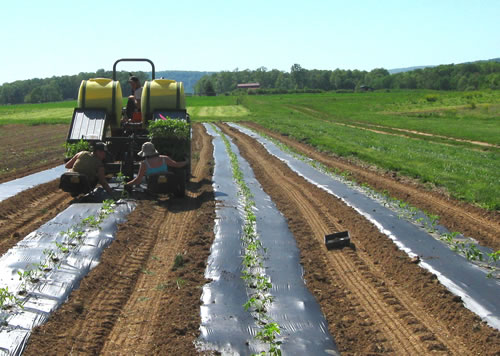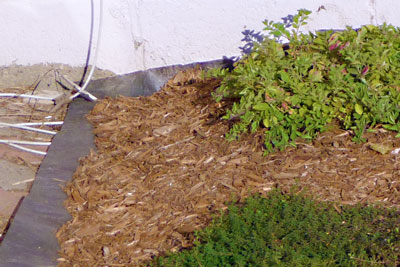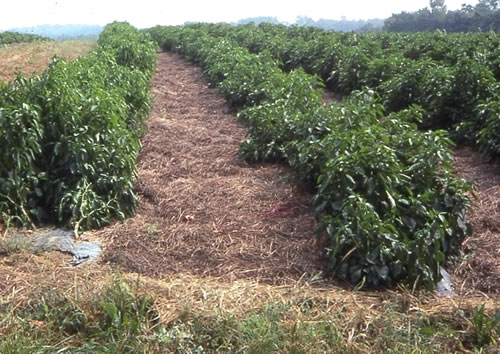As an Amazon Associate, I earn from qualifying purchases.
Spread a 2-3 inch layer of organic mulch around plants to suppress weed growth. Ensure the mulch is not touching the plant stems.
Mulch effectively controls weeds by blocking sunlight, which prevents weed seeds from germinating. Organic mulches, such as wood chips, straw, or leaves, also improve soil health as they decompose. This natural method not only reduces the need for chemical herbicides but also conserves moisture, keeping your garden hydrated longer.
Applying mulch correctly can save you time and effort in maintaining a weed-free garden. Choose the right type of mulch for your plants and apply it properly for the best results. Regularly replenish the mulch layer to maintain its effectiveness throughout the growing season.

Credit: eorganic.org
Benefits Of Mulch
Mulch is a gardener’s best friend. It helps to control weeds and has many other benefits. Using mulch can improve the health of your garden. It reduces the need for frequent watering and keeps your plants happy. Learn how to use mulch to make your garden thrive.
Soil Moisture Retention
Mulch helps the soil retain moisture. This means you do not need to water your plants as often. Mulch forms a barrier on top of the soil. This barrier reduces water evaporation. Here are some ways mulch helps with soil moisture retention:
- It keeps the soil cool and moist.
- It reduces the impact of rain and watering.
- It prevents the soil from drying out too quickly.
Different types of mulch have different moisture retention properties. Organic mulches like wood chips and straw work well. Inorganic mulches like gravel and plastic sheeting can also be effective. Choose the mulch that best suits your garden’s needs.
Temperature Regulation
Mulch helps regulate soil temperature. This is important for plant health. Mulch keeps the soil warm in winter and cool in summer. Here are some benefits of temperature regulation with mulch:
- It protects plants from extreme temperatures.
- It helps seeds to germinate faster.
- It creates a stable environment for plant roots.
Organic mulch decomposes over time. This process adds nutrients to the soil. Inorganic mulch, like stones, does not decompose. It still helps to regulate temperature and can be reused. Choose the type of mulch that best fits your garden’s climate and plants.
Types Of Mulch
Mulch is a great way to control weeds in your garden. It helps to keep the soil moist and adds nutrients. There are many types of mulch you can use. Each type has its own benefits. Understanding these types can help you make the best choice for your garden.
Organic Options
Organic mulch comes from natural materials. It breaks down over time and improves soil health. Some popular organic mulches include bark, straw, and leaves.
- Bark mulch: It is great for flower beds. It lasts a long time and looks nice.
- Straw mulch: This is good for vegetable gardens. It keeps the soil moist and adds nutrients.
- Leaf mulch: This is free if you have trees. It breaks down quickly and improves soil.
Organic mulches are great for the environment. They recycle natural waste and reduce landfill use. They also provide habitats for helpful insects. Using organic mulch can save you money. You might find some of these materials in your own yard.
Inorganic Choices
Inorganic mulch does not break down. It lasts a long time. It includes materials like plastic, gravel, and landscape fabric.
- Plastic mulch: This type blocks light to stop weeds. It is good for large areas.
- Gravel mulch: Gravel looks nice and lasts forever. It is great for paths and driveways.
- Landscape fabric: This fabric lets water through but blocks weeds. It works well under other mulches.
Inorganic mulches are good for long-term solutions. They need less maintenance. They are also good for heavy traffic areas. But they do not add nutrients to the soil. They are best used in decorative areas or where plants do not need extra nutrients.
Choosing The Right Mulch
Mulching is a great way to keep weeds away. It helps the soil stay moist and healthy. Choosing the right mulch is very important. This guide will help you pick the best mulch for your garden.
Consider Plant Types
Different plants need different types of mulch. Some plants like wood chips, while others prefer straw. Using the wrong mulch can harm your plants. To start, make a list of the plants in your garden. Here are some tips for choosing mulch based on plant types:
- Flower beds: Use wood chips or bark mulch. They look nice and break down slowly.
- Vegetable gardens: Straw or grass clippings work well. They add nutrients to the soil.
- Trees and shrubs: Use wood chips or pine needles. These mulches keep the soil cool and moist.
Avoid using mulch that has weed seeds. This can make the problem worse. Make sure to get mulch from a trusted source. Organic mulches are usually the best choice. They break down and add nutrients to the soil. Inorganic mulches like stones or plastic do not break down. They are good for areas where you do not want any plants to grow.
Evaluate Local Climate
Climate plays a big role in choosing the right mulch. In hot, dry areas, mulch helps keep the soil cool and moist. In wet, rainy areas, mulch helps prevent soil erosion. Here are some tips for choosing mulch based on climate:
- Hot, dry climates: Use thick layers of mulch. Wood chips, straw, and grass clippings work well. They keep the soil cool and retain moisture.
- Wet, rainy climates: Use lighter layers of mulch. Pine needles and bark mulch work well. They allow water to drain through.
- Cold climates: Use mulch that insulates the soil. Straw and hay work well. They protect plant roots from freezing.
Mulch can also help regulate soil temperature. In hot climates, it keeps the soil cool. In cold climates, it keeps the soil warm. Make sure to adjust the amount of mulch based on the season. In summer, use more mulch to keep the soil cool. In winter, use less mulch to allow the soil to warm up.
Application Techniques
Mulch is a simple and effective way to control weeds. It helps keep soil moist and adds nutrients as it decomposes. This guide will show you the best techniques for applying mulch to keep your garden weed-free.
Layer Thickness
Choosing the right layer thickness is crucial. Too thin, and weeds will push through. Too thick, and plants might not get enough air.
A 2-4 inch layer of mulch is usually best. This thickness blocks light, which weeds need to grow. It also helps the soil retain moisture.
Here are some tips for different garden areas:
- Vegetable gardens: Use 2-3 inches of mulch.
- Flower beds: A 2-4 inch layer works well.
- Trees and shrubs: Opt for 3-4 inches of mulch.
Applying mulch too thick can cause problems. It might create a barrier that water and air can’t pass through. This can harm your plants. Always check the thickness after applying.
Proper Placement
Correct placement of mulch is just as important as the thickness. Mulch should be spread evenly over the soil. Avoid piling it against plant stems or tree trunks. This can cause rot and attract pests.
Here are steps for proper mulch placement:
- Clear the area of weeds and debris.
- Spread mulch evenly around plants, keeping it 1-2 inches away from stems.
- Water the mulch after spreading to help it settle.
For trees and larger plants, create a mulch ring. Leave a gap around the base of the trunk. This prevents rot and allows the tree to breathe. Regularly check mulch levels and replenish as needed. Proper placement helps keep your garden healthy and weed-free.
Timing For Mulching
Mulching is a great way to control weeds in gardens. It blocks sunlight, preventing weeds from growing. Mulch also retains soil moisture, helping plants thrive. The key to effective mulch use lies in timing. Proper timing ensures maximum weed control and plant health.
Seasonal Considerations
Mulching at the right time of year is crucial. Spring and fall are the best seasons for mulching. In spring, apply mulch after the soil warms up. Cold soil can harm plants. Spring mulching suppresses early weed growth. It also helps soil retain moisture during the hot summer months.
Fall mulching is also beneficial. It helps insulate plant roots from winter cold. Fall mulch decomposes over winter, enriching the soil for spring planting. Avoid mulching in summer. High temperatures can cause mulch to overheat, harming plants. Summer mulching also traps too much moisture, leading to root rot.
Here’s a quick guide:
- Spring: Apply mulch after soil warms.
- Summer: Avoid mulching.
- Fall: Mulch to insulate roots and enrich soil.
Before Planting
Mulching before planting helps prepare the soil. Clear the area of any existing weeds. Use a hoe or hand-pull them. Removing weeds first ensures they don’t grow through the mulch. Next, add organic matter to the soil. Compost or manure works well. This boosts soil nutrients for new plants.
Spread a 2-3 inch layer of mulch over the soil. Don’t pile mulch against plant stems. This can cause rot. Leave a small gap around each plant. Water the area thoroughly after mulching. This helps the mulch settle and stay in place. Mulching before planting gives plants a strong start.
Here are the steps:
- Clear existing weeds.
- Add organic matter to soil.
- Spread 2-3 inch layer of mulch.
- Leave gaps around plant stems.
- Water thoroughly.

Credit: albopepper.com
Maintenance Tips
Mulch is a powerful tool in the battle against weeds. It helps to keep your garden neat and healthy. With the right maintenance, mulch can be very effective. This guide will provide helpful tips on using mulch for weed control. You’ll learn how to replenish mulch and monitor for weeds.
Replenishing Mulch
Mulch breaks down over time. This means you’ll need to add more mulch every so often. Adding fresh mulch keeps your garden looking nice. It also helps to stop weeds from growing.
Here are some steps for replenishing mulch:
- Check the mulch depth. It should be about 2 to 3 inches thick.
- Remove old mulch if it looks moldy or slimy.
- Spread new mulch evenly around plants and trees.
- Keep mulch away from plant stems and tree trunks.
- Water the area after adding new mulch.
Using the right type of mulch is also important. Organic mulch, like wood chips or straw, breaks down and adds nutrients to the soil. Inorganic mulch, like stones or rubber, does not break down. Choose the type that best fits your garden’s needs.
Replenishing mulch regularly helps keep weeds at bay. It also improves soil health and moisture.
Weed Monitoring
Even with mulch, you should still watch for weeds. Regular monitoring helps catch weeds early. This makes them easier to remove. Here are some tips for monitoring weeds:
- Check your garden at least once a week.
- Look for weeds poking through the mulch.
- Pull weeds by hand as soon as you see them.
- Use a hoe for larger areas with many weeds.
Keeping an eye on your garden helps you act quickly. Early removal prevents weeds from spreading. You can also use a pre-emergent herbicide. This stops weed seeds from sprouting. Just be sure to follow the instructions on the label.
With these tips, you’ll be able to keep your garden weed-free. Regular monitoring and replenishing mulch are key to success.
The right amount of mulch is around 2-3 inches thick. This is enough to keep weeds away. It also allows water and air to reach the soil. Always spread mulch evenly. Avoid piling it up around plant stems. This can cause rot and disease.
Neglecting Edges
Neglecting edges is another common mistake. Weeds love to grow along the edges of mulch beds. If you forget the edges, weeds will sneak in.
Follow these tips to manage edges:
- Create a border: Use stones or bricks to make a clear border. This helps keep mulch in place and weeds out.
- Regular check: Look at the edges often. Pull out any weeds you see.
- Edge trimming: Trim the edges of your mulch bed. This prevents grass and weeds from creeping in.
Proper edge maintenance is key. It keeps your garden neat and weed-free. Spend a few minutes each week checking the edges. This small task can save you a lot of work later. Keep your mulch beds well-defined and clean.

Credit: eorganic.org
Mulch Alternatives
Mulch is a gardener’s best friend. It helps keep weeds at bay. But there are many mulch alternatives to consider. These options can be just as effective. They might even be better for your garden. This blog will explore some of these alternatives. You’ll learn how to use them for weed control.
Ground Covers
Ground covers are a great mulch alternative. They provide a natural barrier against weeds. These plants spread across the ground. They block sunlight from reaching weed seeds. This prevents weeds from growing. Some popular ground covers include:
- Clover: This plant enriches the soil with nitrogen.
- Thyme: It has a pleasant scent and is low maintenance.
- Creeping Jenny: This plant is great for shady areas.
- Sedum: It thrives in sunny spots and needs little water.
Ground covers also add beauty to your garden. They come in many shapes and colors. This can make your garden look more vibrant. Plus, they help conserve soil moisture. This means you’ll need to water your plants less often.
Another benefit is that ground covers improve soil health. Their roots help keep the soil loose. This allows air and water to reach plant roots more easily. So, ground covers are not just for weed control. They also make your garden healthier and prettier.
Landscape Fabrics
Landscape fabrics are another effective mulch alternative. These fabrics block weeds by creating a physical barrier. They are easy to install and come in rolls. Just cut the fabric to fit your garden beds. Then, lay it down and secure it with garden staples. This prevents weeds from growing through the soil.
Here are some benefits of using landscape fabrics:
- Durability: These fabrics can last for several years.
- Water Permeability: Water can still reach plant roots.
- Ease of Use: Installation is quick and simple.
- Low Maintenance: Little upkeep is needed after installation.
Landscape fabrics reduce the need for chemical weed killers. This makes your garden safer for kids and pets. They also help maintain soil temperature. This is important for plant health. In hot weather, the fabric keeps the soil cool. In cold weather, it helps retain warmth.
While landscape fabrics are effective, they are not perfect. They can be expensive. Some people find them unattractive. But you can cover the fabric with a layer of organic mulch. This hides the fabric and adds nutrients to the soil. So, landscape fabrics are a versatile and useful tool for weed control.
Frequently Asked Questions
What Is Mulch And Why Use It?
Mulch is a layer of material spread over soil. It helps retain moisture, suppress weeds, and improve soil health.
How Does Mulch Prevent Weeds?
Mulch blocks sunlight from reaching weed seeds. This prevents their germination and reduces weed growth significantly.
When Is The Best Time To Apply Mulch?
The best time to apply mulch is in late spring. This is when soil has warmed up but is still moist.
How Thick Should Mulch Be For Weed Control?
For effective weed control, apply mulch 2-4 inches thick. This thickness helps block sunlight and retain soil moisture.
Conclusion
Using mulch for weed control is an effective and natural method. It conserves moisture, improves soil health, and suppresses weeds. Choose the right type of mulch for your garden’s needs. Apply it properly for the best results. Start mulching today and enjoy a healthier, weed-free garden.
Happy gardening!

